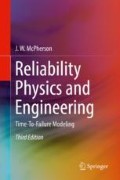Abstract
All materials tend to degrade, and will eventually fail, with time. For example, metals tend to creep and fatigue; dielectrics tend to trap charge and breakdown; paint tends to crack and peel; polymers tend to lose their elasticity and become more brittle, teeth tend to decay and fracture; etc. All devices (electrical, mechanical, electromechanical, biomechanical, bioelectrical, etc.) will tend to degrade with time and eventually fail. The rate of degradation and eventual time-to-failure (TF) will depend on the electrical, thermal, mechanical, and chemical environments to which the device is exposed.
Access this chapter
Tax calculation will be finalised at checkout
Purchases are for personal use only
Notes
- 1.
The divergence theorem states that: \( {\int}_V\overrightarrow{\nabla}\cdot \overrightarrow{J}\;\mathrm{d}V={\int}_A\overrightarrow{J}\cdot \mathrm{d}\overrightarrow{A} \), where V is the volume of interest which is bounded by a surface of area A.
- 2.
The reaction-rate constant, in many cases, may not really be constant. It may, in general, be a function of time.
- 3.
We have inserted the identity: \( \mathrm{TF}={\int}_0^{\mathrm{TF}}\mathrm{d}t. \)
- 4.
This is generally true for EM-induced failure in conductors. Wider metal leads, at the same current density stress, tend to last longer. An apparent exception seems to exist in aluminum where very narrow metal leads can last longer than wider metal leads during EM testing. With aluminum, a bamboo-like grain-boundary microstructure can develop when the metal width and thickness are comparable to the Al grain size. Here, however, the amount of flux divergence is no longer constant, but is reduced by the bamboo grain structure thus causing the narrow metal leads to last longer than the wider leads.
- 5.
To properly use this equation, the temperature T must be expressed in Kelvin.
- 6.
This can be a very important issue if the stress also tends to serve as a significant source of self-heating, e.g., Joule heating can raise the temperature of the conductor when the current density stress is increased in a metal stripe during EM testing. This temperature rise (with the level of current-density stress) must be taken into account when determining the failure kinetics.
- 7.
Remember that one must convert the temperature from Centigrade to Kelvin. The conversion equation is T(K) = T(°C) + 273.
- 8.
Identity is used: exp(−γξBD) exp(γξBD) = 1.
- 9.
In Problem 7, at the end of this chapter, it is shown that a stress-dependent activation energy also develops if a Maclaurin Series expansion is used: γ(T) = a0 + (a1KB)T.
- 10.
The occurrence of a stress-dependent activation energy (for high level of stress) is discussed in detail in Chap. 8.
Bibliography
McPherson, J.: Stress Dependent Activation Energy, IEEE International Reliability Physics Symposium Proceedings, 12(1986).
McPherson, J. and E. Ogawa: Reliability physics and engineering. In: Handbook of Semiconductor Manufacturing Technology, 2nd Edition, CRC Press, (2008).
Author information
Authors and Affiliations
Problems
Problems
-
1.
If a constant flux divergence exists, and is given by:
$$ \int \overrightarrow{J}\cdot \mathrm{d}\overrightarrow{A}=R=\frac{100,000\;\mathrm{Billion}\kern0.17em \mathrm{atoms}}{\mathrm{s}}, $$find the time required for 50 % of the atoms to flow out of 1 cm3 of aluminum. Hint:
$$ {\displaystyle \begin{array}{c}{N}_{\mathrm{atoms}}=\frac{{\left(\mathrm{density}\right)}_{\mathrm{A}1}{\left(\mathrm{Vo}1\mathrm{ume}\right)}_{\mathrm{A}1}}{{\left(\mathrm{atomic}\kern0.17em \mathrm{weight}\right)}_{\mathrm{A}1}}=\frac{\left(2.7\mathrm{g}/{\mathrm{cm}}^3\right)\left(1{\mathrm{cm}}^3\right)}{\left(27.0\mathrm{g}\right)/\left(6.02\times {10}^{23}\mathrm{atoms}\right)}\\ {}=6.0\times {10}^{22}\;\mathrm{atoms}\end{array}} $$Answer: 9.5 years
-
2.
If the reaction-rate constant k shows a monotonic time dependence, then Chap. 2 suggests that one can approximate the time dependence with:
$$ k(t)={k}_0\left[1\pm {a}_0{t}^m\right], $$where the plus (+) sign is used for an increasing reaction rate constant and a minus (-) sign for a decreasing reaction rate constant. Using Eq. (5.3), show that the TF is given by the transcendental equation:
$$ \mathrm{TF}=\frac{\ln \left[{N}_0/N\left(t=\mathrm{TF}\right)\right]}{k_0\left[1\pm {a}_0\frac{{\left(\mathrm{TF}\right)}^m}{m+1}\right]}. $$ -
3.
EM testing of Cu produced the following table of TF results:
Electromigration time-to-failure data
1 × 106 (A/cm2)
2 × 106 (A/cm2)
3 × 106 (A/cm2)
280 °C
–
20.3 h
–
300 °C
20 h
10 h
6.7 h
320 °C
–
5 h
–
-
(a)
Find the power-law exponent n for the current density.
-
(b)
Find the activation energy Q for this failure mechanism.
Answers: (a) n = 1 (b) Q = 1.0 eV
-
(a)
-
4.
Corrosion testing of a metal produced the following table of TF results:
Corrosion time-to-failure data
Corrosion time-to-failure data
60 % RH
70 % RH
80 % RH
25 °C
–
824 h
–
50 °C
332 h
100 h
30 h
75 °C
–
16.4 h
–
-
(a)
Find the exponential-dependence parameter γ for the humidity.
-
(b)
Find the activation energy for this failure mechanism.
Answers: (a) γ = 0.12 (%RH)-1 (b) Q = 0.7 eV
-
(a)
-
5.
Testing for surface-inversion/mobile-ions in ICs produced the following TF results:
Mobile-Ions time-to-failure data
3 V
6 V
9 V
60 °C
–
67.70 h
–
70 °C
40 h
20 h
13.30 h
80 °C
–
6.33 h
–
-
(a)
Find the power-law exponent n which describes the voltage dependence.
-
(b)
Find the activation energy Q for this failure mechanism.
Answers: (a) n = 1 (b) Q = 1.2 eV
-
(a)
-
6.
Testing for channel hot-carriers in n-type MOSFETs produced the following TF results.
Hot-Carrier injection time–to–failure data
5 μA/μm
15 μA/μm
25 μA/μm
25 °C
–
5.65 h
–
50 °C
324 h
12 h
2.60 h
75 °C
–
22.90 h
–
-
(a)
Find the power-law exponent n which describes the substrate current dependence.
-
(b)
Find the activation energy Q for this failure mechanism.
Answers: (a) n = 3 (b) Q = −0.25 eV
-
(a)
-
7.
Using Eq. (5.13b) for TF, and assuming that the temperature dependence of γ can be expressed by the Maclaurin Series:
$$ \gamma (T)\cong {a}_0+\left({a}_1{K}_B\right)T, $$show that a stress-dependent activation energy develops of the form:
$$ {Q}_{\mathrm{eff}}=Q-{a}_1{\left({K}_BT\right)}^2\xi . $$
Rights and permissions
Copyright information
© 2019 Springer Nature Switzerland AG
About this chapter
Cite this chapter
McPherson, J.W. (2019). Time-to-Failure Modeling. In: Reliability Physics and Engineering. Springer, Cham. https://doi.org/10.1007/978-3-319-93683-3_5
Download citation
DOI: https://doi.org/10.1007/978-3-319-93683-3_5
Published:
Publisher Name: Springer, Cham
Print ISBN: 978-3-319-93682-6
Online ISBN: 978-3-319-93683-3
eBook Packages: EngineeringEngineering (R0)

